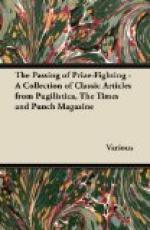“OH, OH, OH! CONFOUND IT!”
“WHAT IS THE MATTER, ALGY?”
“I JUST LET MY FOOT OUT ON THE STIRRUP, AND THIS BEAST OF A PONY’S TROD ON MY TOE!”]
* * * * *
HYMEN AND CUPID.
(FIN-DE-SIECLE VERSION, SOME WAY AFTER MOORE.)
HYMEN, late, his love-knots selling,
Called at many a maiden’s dwelling;
But he found too well they knew him;
None were prompter to pooh-pooh him.
“Who’ll buy my
love-knots?
Who’ll buy my love-knots?”
Soon as that old cry resounded.
How his baskets were surrounded!
Maidens mocked, with laughter dying,
Those fool-knots of HYMEN’s tying;
Dames, who once with him had sided,
Openly his wares derided.
“Who’ll buy my
love-knots?
Who’ll buy my love-knots?”
All at that old cry came flocking,
Mocking in a style quite shocking.
“Here are knots,” said HYMEN,
taking
Some loose nooses of Law’s making.
“Pooh!” the nymphs cried.
“Who can trust ’em?
We have changed your queer old custom.
Who’ll buy your love-knots?
Who’ll buy your love-knots?
Women they bind not, nor tie men.
You’re a helpless gaoler, HYMEN!
“When the bargain is completed,
We have but to cry, ‘We’re
cheated!’
And you’ll find you’re sold
most sadly.
Love-knots? Fools’-knots!
They tie badly.
Who’ll buy your
love-knots?
Who’ll buy your
love-knots?
Burdens you would lay our backs on—
Our reply is—TOLSTOI!
JACKSON!”
HYMEN dropped his torch; its splutter
Was extinguished in the gutter.
“At my torch and crown of roses
These young minxes cock their noses.
Who’ll buy my love-knots?
Who’ll buy my love-knots?”
What’s the use? ’Twixt
Law and Passion,
HYMEN’s plainly out of fashion!
LOVE, who saw the whole proceeding,
Would have laughed but for good breeding.
“Best join me,” he
cried, “Old Chappie!
IBSEN read, be free, and happy!
Who’ll buy your love-knots?
Who’ll buy your love-knots?
Have a spree—all shackles scorning,
Come! We won’t go home till
morning!’”
* * * * *
A BACONIAN THEORY;
OR, TRYING IT ON.
SOLOMON isn’t in it with Judge BACON. The point was whether Mrs. MANLEY had made Miss DOROTHY DENE’s dresses to fit or not. “To fit or not to fit, that was the question.” The Judge gave his decision after a fair trial of the two costumes—this might be remembered on both sides as “the trying-on case,”—that, according to the evidence of unimpeachable witnesses represented by the Judge’s own common-sense and artistic eye for effect, two of the dresses and a cloak didn’t fit, and that so far, the Defendant, Miss DOROTHY, must consider herself, in a dress-making




